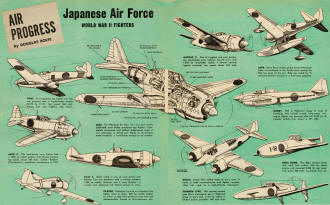|
The December 1954 edition of Air Trails
magazine, a mere decade past the end of World War II, did a short feature on 11 of the Japanese
Air Force's most important airplanes. Description and role for each model is brief. Line drawings are
provided. You might want to add a little color with a graphics editor and print out the image to use
as a poster.
See the previous month for
Air Progress - Japanese Air Force After World War I
Japanese Air Force World War II Fighters
By Douglas Rolfe
As remarked in the previous installment, the highly secretive and generally imitative qualities of
prewar Japanese military aviation made it difficult to gauge its strength. It was generally thought,
up to Pearl Harbor, that the quality of the Jap equipment and personnel was far below Western standards.
Yet, our own aircraft were completely out-classed during the first year or so of the struggle. With
this in mind the planes illustrated on these pages are limited. to the more troublesome Jap fighters
which outflew our best during the early days, and to some models which were in the development stage
at the close of hostilities. These latter show a real talent for imaginative thinking and advanced design
developed by the Japanese aircraft industry since the days when they merely copied Occidental designs.
It can be noted, however, that nearly all these aircraft still betray strong Western influence - notably
that of U.S. and German design. The fact remains that the lightly loaded, poorly armed and armored Jap
fighters taught us some sharp lessons under combat conditions and their pilots proved much better than
had been dreamed of.

TONY. This important Jap fighter was only one powered with a liquid-cooled engine
(1,175 hp V-12). Top speed: 360 mph. Among first Jap fighters with armor.
ZEKE. The Mitsubishi 52, Type "O", was most widely publicized, most widely produced
Jap fighter. Completely unarmored and without bullet-proof tanks, it was vulnerable to attack but, thanks
to its extreme maneuverability, a formidable weapon in air combat.
JACK 11. This land-based navy fighter had a 1800 hp radial engine; four 20-mm cannon;
top speed, about 380 mph. Called "Raiden" (Thunderbolt); superficial resemblance to P-47.
TOJO 2. Often rated as one of most potent Jap fighters, Tojo was produced only in
limited numbers. 1,450 hp radial; fuselage and 2 wing M/guns. A number were equipped with 40-mm cannon
in wings.
CLAUDE. Nakajima Type 96 was standard Jap fighter prior to Zeke. 800 hp radial engine,
no armor or fuel tank protection but fast and maneuverable. Served in Sino-Japonese war.
GEORGE 11. One of toughest and most dangerous land-based navy fighters toward war's
end. 1,990 hp 18-cylinder radial; 4 20-mm cannon; heavily armored; top speed about 370 mph.
RUFE. Navy float version of the famed Mitsubishi ZEKE. Encountered in the Pacific
area during the first two years of the war, Rufe was noted for its maneuverability - unusual in a float
type seaplane.
RANDY. Still in flight-test stage at close of hostilities, this heavily armed, long-range,
twin-engine fighter was powered with two 2,200 hp 18-cylinder radials - top speed of 437 mph.
BAKA BOMB. The Baka piloted bomb had solid fuel rocket 1760 lb. thrust engine and
mounted 2,200 lb. war head. Top speed 535 mph. Launched from air.
DINAH. Faster than Allied types at war's, start, it came in both reconnaissance
and fighter versions. Later was used as a high-altitude interceptor.
SHINDEN J7W1. This unusual canard-type Navy interceptor was in flight-test stage
at war's end. 2,130 hp radial, 6-bladed pusher propeller; 405 mph tops.
Douglas Rolfe Drawings
-
Post-Pusher Parade, May 1961 American Modeler
-
Air Progress: The Jet Engine, July 1951 Air Trails
-
Air Progress: The Bristol Story, November 1948 Air Trails
-
Auto
Progress: Down Memory Lane III, December 1954 Air Trails
- Auto
Progress: Memory Lane Collection No. 2, August 1954 Air Trails
-
Air Progress Famous Firsts, August 1954 Air Trails
-
Air Progress: Japanese Air Force World War II Fighters, December 1954 Air Trails
-
Air Progress: Lindbergh Era (1927-1929), July 1954 Air Trails
-
Air Progress: The Search for Speed, November 1950 Air Trails
-
Air Progress: Soviet Air Force Latter Day Types, March 1955 Air Trails
Posted February 10, 2013
|